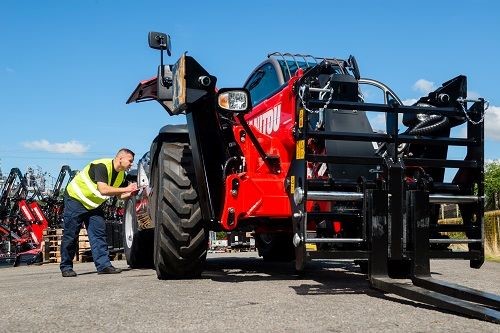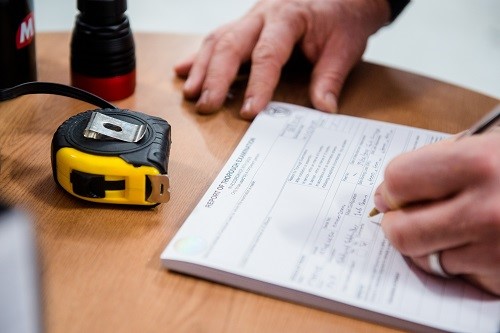Materials handling equipment like forklifts must undergo a regular Thorough Examination to ensure its safety, but it’s vital to check the person carrying out the inspection has the necessary skills, knowledge and competence.
Features
Examine the examiner
Although businesses usually take a great amount of time and care when selecting the most appropriate and safest materials handling equipment (MHE) for their needs, it seems not all companies take a similar approach when it comes to deciding who carries out the regular Thorough Examinations of the equipment, a safety check that is required by law.
Often, when purchasing insurance to cover the risks from using MHE at work (like a counterbalance forklift or telehandler), the insurance company will offer, or include, the services of an inspector to undertake the Thorough Examination. This is a default arrangement but it is not obligatory to use the insurer’s own inspector and this may not necessarily deliver the best outcome in terms of the quality of the Thorough Examination.
So, when a business needs to engage a competent person to carry out a Thorough Examination of equipment like forklifts, it is therefore worth investing some time in exploring and examining the options.
Put simply, a Thorough Examination is a mandatory inspection required by law to ensure that the mechanical parts of a lift truck – and other relevant types of MHE like telehandlers and stacker trucks – are in safe working order. These types of work equipment must receive a Thorough Examination by a competent person at least once a year, although examinations could be required more frequently depending on factors like the type of truck, the way it is used, the type of attachments fitted to it and the likelihood of dangerous faults arising during its everyday use.
 Photo: CFTS
Photo: CFTS
A Thorough Examination must comprehensively cover both the lifting and the driving mechanisms of the lift truck. This includes things such as the lifting mechanism, mast forks and chains, attachments (like safety cages and barrel clamps), brakes, steering and tyres.
So, what kind of things should a business consider when deciding what constitutes a genuinely appropriate, comprehensive and suitable Thorough Examination for their lift trucks and other MHE?
How long should an inspection last?
The duration of the inspection will vary according to the size and complexity of the vehicle or machine concerned. However, as a basic rule of thumb, the Thorough Examination of, say, a 1.5 tonne three-wheel electric forklift should take a minimum of 45 minutes. Anything less and the inspection could have been rushed. A conventional telehandler, for example, might take three hours to inspect properly. Generally speaking, the rule is: it takes as long as it takes.
What’s covered?
Mistakenly, some see the terms ‘LOLER’ (Lifting Operations and Lifting Equipment Regulations 1998), and ‘Thorough Examination’ as interchangeable, which can be dangerously misleading.
According to the Health and Safety Executive (HSE), a Thorough Examination should embrace the requirements of both LOLER and PUWER (Provision and Use of Work Equipment Regulations 1998). In practice that means not simply checking the lifting systems and components (including mast, forks, chains, etc.) covered by LOLER, but also the steering, braking and traction systems, along with overhead guards, wheels, tyres, seats, etc, in order to comply with PUWER.
 Geoff Martin: "Unlike a car, handling/lifting equipment must be examined at least every 12 months."
Geoff Martin: "Unlike a car, handling/lifting equipment must be examined at least every 12 months."
However, in some cases, the Thorough Examinations offered and undertaken by some third-party companies and individuals for customers do not align with what HSE would view as a being a suitable and sufficient Thorough Examination that checks the safety of all relevant parts and functions of the lift truck.
For any business that owns lift trucks, it is therefore essential they can satisfy themselves that any Thorough Examination carried out on their behalf comprehensively covers and checks all the relevant safety-critical areas for the truck’s lifting and driving mechanisms and any attachments.
What equipment is used by the examiner?
There are no regulations regarding what equipment should be used in a compliant Thorough Examination of a lift truck or other relevant type of MHE. However, common sense suggests that, as a minimum, the inspector should carry: a harness for working at height; truck blocks to secure equipment; torches to inspect defects; UV (ultraviolet light) torches for crack detection; toe jacks for better access; rachet straps to secure masts and forks; mast blocks for checking wear on mast pivot brushes and for securing equipment during steering inspections; and cones or barriers to ensure inspections take place in segregated areas.
If the person undertaking the examination does not have these present and to hand, this is an immediate red warning flag.
Today’s inspectors should also carry modern, specialised equipment designed to give precise, repeatable and transparent results that can easily be shared with the customer. Typically, these include a professional chain wear gauge (rather than, say, a steel ruler), fork wear gauge, fork wear caliper, digital angle protractor and set square.
 It’s vital to check the person carrying out the inspection has the necessary skills, knowledge and competence. Photograph: CFTS
It’s vital to check the person carrying out the inspection has the necessary skills, knowledge and competence. Photograph: CFTS
These tools are not merely essential equipment though. They serve as a strong indicator of the type of inspection a business is likely to receive. If an inspector isn’t equipped with these items, there is a very good chance your equipment is not being assessed to the very highest standard.
Appropriate documentation
The correct paperwork is another vital component in the process of ensuring, beyond doubt, that everything has been carried out in compliance with HSE guidelines to ensure the safety of the MHE.
It starts with the inspection checklist. Surprisingly, and in marked contrast to a car’s MOT, each examiner is free to create their own procedure. The advice from CFTS, however, would be to seek out an examining body that uses nationally accredited documentation. This is particularly applicable if your organisation operates across more than one site since consistency can be crucial.
Similarly, if the business operates different types of equipment, it is important to obtain a copy of the inspection checklist for each type. One size does not fit all and there are different inspection and Through Examination requirements for counterbalance and warehouse trucks, just as there are for telehandlers, tractors, MEWPs (mobile elevating work platforms, such as cherry pickers and scissor lifts). There are also different inspection requirements for the Thorough Examination of attachments, such as bale clamps and cages (in fact, some of these may need a separate inspection entirely).
Once the Thorough Examination is complete the examiner should provide the customer with clear information on the results. This may identify remedial actions that are required to ensure the safety of the MHE and should state or recommend when the next Thorough Examination should take place.
Typically, the written documentation should include:
- A report of the Thorough Examination
- An itemised checklist showing what has been inspected and comments made (with a separate checklist for non-permanent truck attachments)
- A Thorough Examination certificate which should be retained with the vehicle’s documents for at least two years
- A sticker showing when any repairs must be completed by
- A sticker placed prominently on the equipment showing the day, month and year that the next Thorough Examination is due (this is important as, unlike a car’s MOT, there is no ‘grace period’).
If the person or company that undertakes Thorough Examinations does not provide all this information and documentation, it may be a sign that the inspector is providing a sub-standard service.
How often should the machine undergo a Thorough Examination?
Unlike a car, handling/lifting equipment must be examined at least every 12 months – starting from when it was new – or possibly more frequently depending on the nature of the work it does and the environment in which it operates.
For example, equipment used in highly corrosive/demanding environments or used for lifting personnel will need to be inspected every six months or even more frequently.
In situations where an exceptional event has occurred – such as an impact or overload – an additional Thorough Examination is required before the equipment is brought back into service. This also applies where equipment has been inactive for a prolonged period (as was often the case during the Covid pandemic).
The organisation or individual that provides the Thorough Examination service should be able to advise the customer on the appropriate frequency of the examination. Alternatively, CFTS offers an online timings calculator that gives a general indication of how often a truck might need a Thorough Examination.
A practical consideration
Although the paramount concern when selecting a Thorough Examination provider will be ensuring they will properly and adequately inspect, assess and report on the safety of the truck, real world considerations are bound to come into play. For many businesses, if a key piece of equipment like a lift truck needs to be removed from service for safety-critical repairs or maintenance, this can have serious consequences in terms of problems like lost production, missed deadlines or deterioration of perishable goods.
So, what happens if faults identified during an inspection require a truck to be sidelined?
Most inspectors’ involvement ends with identifying a problem, leaving the truck’s owner to organise the necessary repairs. This will often result in delays in getting the machine back into service due to the need to wait for a service engineer to arrive.
One way of avoiding this is to use an examination provider whose inspectors are trained and practising engineers, who not only have the knowledge and competence to carry out a Thorough Examination and report any faults, but also the skills and equipment to repair the truck.
A comparable situation is when a local garage can make the necessary repairs when a car fails its MOT.
One way of finding inspectors who have the skills and competence to carry out both Thorough Examinations and repairs is through CFTS, the national accreditation body for Thorough Examination and Safety Inspections of MHE, like lift trucks.
CFTS provides and sets clear, definitive procedures and consistent national standards to ensure Thorough Examinations are carried out correctly. Individuals and organisations that offer Thorough Examinations can gain accreditation from CFTS, which demonstrates they will undertake the inspections in line with the necessary safety legislation, CFTS guidelines and industry standards. To be accredited by CFTS – and to maintain their accreditation – a competent person who carries out the inspections must undergo a demanding Thorough Examination course and regular refresher training. They must also meet CFTS’s nationally agreed criteria.
In addition, each company accredited by CFTS to undertake the inspections is subject to regular inspection by CFTS to ensure it continues to meet the high standard demanded by CFTS. Currently, there are over 700 member depots in the UK accredited by CFTS to undertake Thorough Examinations, so it is easy to find a local inspection provider.
For more information see: thoroughexamination.org
Geoff Martin is Chairman at the CFTS
FEATURES

Why line managers play a vital role in workplace wellbeing
By Marcus Herbert, British Safety Council on 03 September 2023
The behaviours of line managers can have a positive or negative impact on employee health, wellbeing and engagement, so it’s vital managers get staff feedback on whether their management style is supportive or negative, and have regular check-ins so workers can raise concerns about their wellbeing.

Watercooler Event to hone in on eight trends in employee health and wellbeing
By Claire Farrow, Make a Difference Events & Media on 15 April 2024
The free-to-attend Water Cooler Event at ExCeL London on 23–24 April will see more than 6,000 workplace experts coming together to explore the latest thinking, solutions and best practice for supporting and boosting employee wellbeing, diversity and workplace culture.

Sedentary working and how to combat the ‘sitting disease’
By Gavin Bradley, Active Working on 05 April 2024
Prolonged and excessive sitting poses a major risk to our health, but the Get Britain Standing campaign and On Your Feet Britain Day on 25 April are a great way of encouraging workers to sit less and move more.



